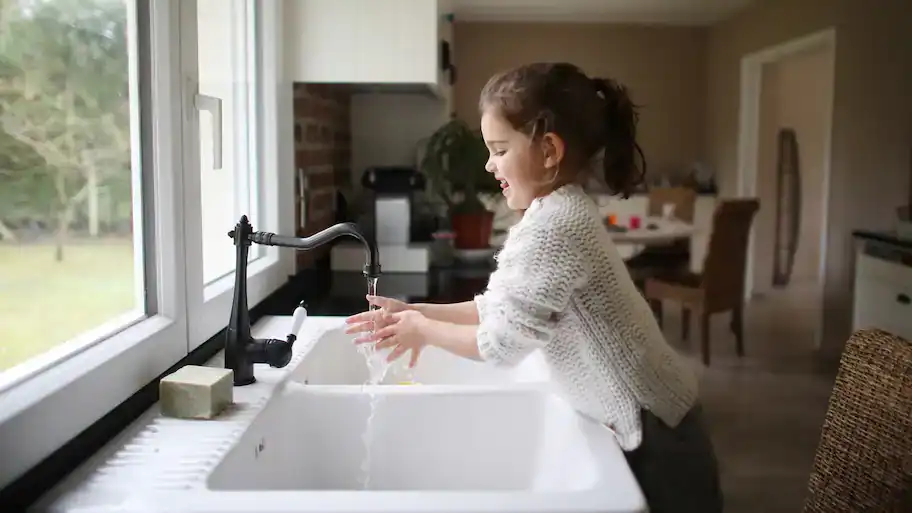Regarding household plumbing, the kitchen sink is vital in daily cooking, cleaning, and food preparation. But have you ever wondered where all that water and waste go after you wash your dishes? In this article, we’ll explore the connection between your kitchen sink and the sewer line, diving into the plumbing basics to help you understand how this essential system works.
The Basics of Kitchen Plumbing:

Before we delve into the specifics of the sewer line connection, let’s first review the basics of kitchen plumbing. Your kitchen sink has a series of pipes and fixtures that work together to transport water in and out of the sink.
- Sink Basin: This is the main bowl of the sink where water accumulates. It typically has a drain at the bottom to allow water flow.
- Sink Drain: The sink drain is connected to the bottom of the sink basin and serves as the exit point for wastewater. It has a strainer or stopper to prevent food particles and debris from clogging the drain.
- P-Trap: The P-trap is a curved section of pipe located underneath the sink drain. It is designed to hold water, prevent sewer gases from entering the home, and provide a barrier against odors.
- Tailpiece and Trap Arm: The tailpiece is a short vertical pipe connecting the sink drain to the trap arm, a horizontal pipe leading to the sewer line.
Connection to the Sewer Line:
Once wastewater exits the sink drain, it flows through the trap arm and into the sewer line. The sewer line is a larger pipe that carries wastewater from your home to the municipal sewer system or septic tank. It is typically buried underground and connects to the main sewer line or septic tank outside the house.
- Municipal Sewer System: In urban and suburban areas, homes are typically connected to a municipal sewer system managed by the local government. The sewer line from your kitchen sink merges with other household wastewater pipes before entering the main sewer line. From there, the wastewater travels to a wastewater treatment plant for processing and disposal.
- Septic Tank: In rural areas or homes not connected to a municipal sewer system, wastewater is directed to a septic tank on the property. The sewer line from your kitchen sink connects to the inlet pipe of the septic tank, where solid waste settles to the bottom and is broken down by bacteria. Liquid waste flows from the septic tank into a drain field, filtered, and absorbed into the soil.
Maintenance and Care:
Proper maintenance and care of your kitchen plumbing system are essential to ensure smooth operation and prevent clogs, leaks, and odors. Here are some tips to keep your kitchen sink and sewer line in good condition:
- Regular Cleaning: Clean your sink drain and P-trap regularly to remove debris, grease, and food particles that can cause clogs and odors. Use a drain cleaner or homemade baking soda and vinegar solution to flush away the buildup and clear the pipes.
- Avoiding Grease Buildup: Avoid pouring grease, oil, and fat down the kitchen sink drain, as they can solidify and cause blockages in the pipes. Instead, collect grease in a container and dispose of it in the trash or recycle it if possible.
- Using a Strainer: Install a filter or drain basket in your sink to catch food scraps and debris before they enter the drain. Empty the filter regularly and dispose of the contents in the trash to prevent clogs.
- Checking for Leaks: Inspect the pipes, fittings, and connections under the sink for signs of leaks or corrosion. Repair any leaks promptly to prevent water damage and mold growth.
- Professional Inspection: Consider hiring a licensed plumber to inspect your kitchen plumbing system annually. A plumber can identify any issues or potential problems and recommend repairs or maintenance to keep your plumbing in top condition.
Common Issues and Solutions:
Despite your best efforts to maintain your kitchen plumbing system, you may encounter occasional issues that require attention. Here are some common problems and solutions related to kitchen sink and sewer line connections:
- Clogs: If your sink drain becomes clogged, use a plunger or plumbing snake to clear the blockage. Avoid using chemical drain cleaners, which can damage the pipes and the environment.
- Leaks: If you notice water pooling under the sink or dripping from the pipes, check for loose fittings or damaged seals. Tighten connections or replace worn-out gaskets to stop the leak.
- Odors: If you detect foul smells from the sink drain, it may be due to a dry P-trap or buildup of organic matter. Run water down the drain to refill the trap and flush away any debris causing the odor.
- Slow Draining: If water drains slowly from the sink, it may indicate a partial clog or pipe obstruction. Try flushing the drain with hot water or using a plumbing drill to remove the blockage.




